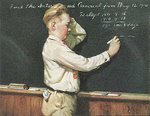 Oh, the multi-purpose phrasal verb. You take on so many interpretations.
Oh, the multi-purpose phrasal verb. You take on so many interpretations. As the students of the 109.02 class dive headlong into the first draft of their second papers--for which they are to read a blog/online article summarize it, and respond to it--I thought it was a good opportunity to discus the merits of the reverse outline.
Written after a draft of a paper is complete, a reverse outline is an attempt to describe the text that has been written, whereas a traditional outline, usually sketched before drafting, is typically an attempt to impose (prescribe) a structure and focus for the paper. When writing a reverse outline, an author writes down a few words that describe the topic of the paragraph. When the author discovers more or fewer than one paragraph topic, he may need to reconsider that paragraph. This also provides a wonderful opportunity to check a paper's organization between paragraphs (a popular understanding of the nebulous "paper flow").
Traditional outlines are written and assigned with the intent of helping the author collect his or her thoughts and organize them. Reverse outlines--well, they are written and assigned for just the same reason. Neither outline is essentially superior to the other; typically, their applicability to a writing task is dependent upon the author. Do you need to organize your thoughts before writing? Be traditional. Do you need to get your ideas out first before ordering them? A reverse outline is for you. Most experienced writers find time for conducting both outlines, even if just on scratch paper (like me), in the paper's margins (like me), or in their heads (like . . . well, you get it by now).
Remember the things to look out for when writing a reverse outline:
- Paragraphs that have more or less than one central topic.
- Paragraphs that do not work in transition to one another or in their place in the paper as a whole.
- Paragraphs that are not meeting the expectations of the assignments (for example, in this assignment, the readers would expect to see a summary of the original blog early on in the paper)
Long live the reverse outline! And while we're revering backward things, let's hear it for the moonwalk, Kriss Kross's clothes, and Cooper's Dream from Twin Peaks!
Perhaps next week we'll look at another meaning of "backing up," that of supporting our writing with examples, statistics, anecdotes, and the like.











